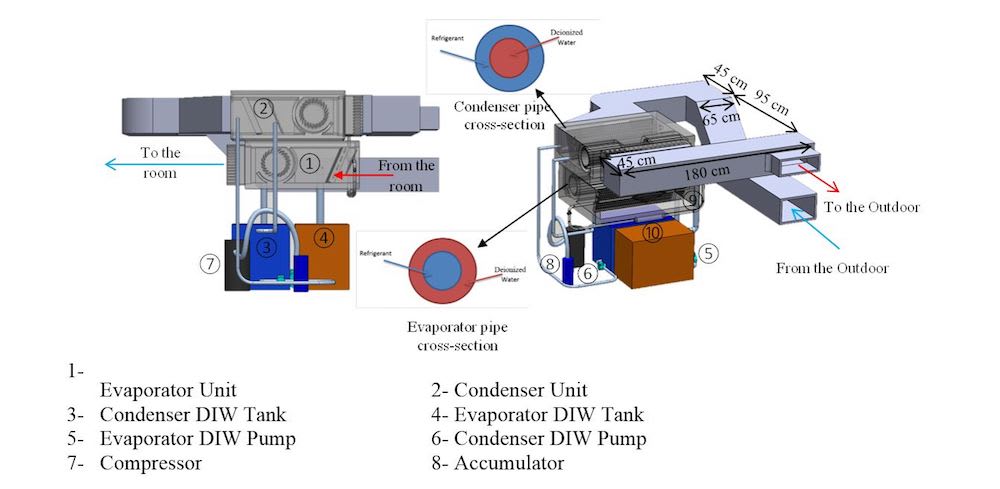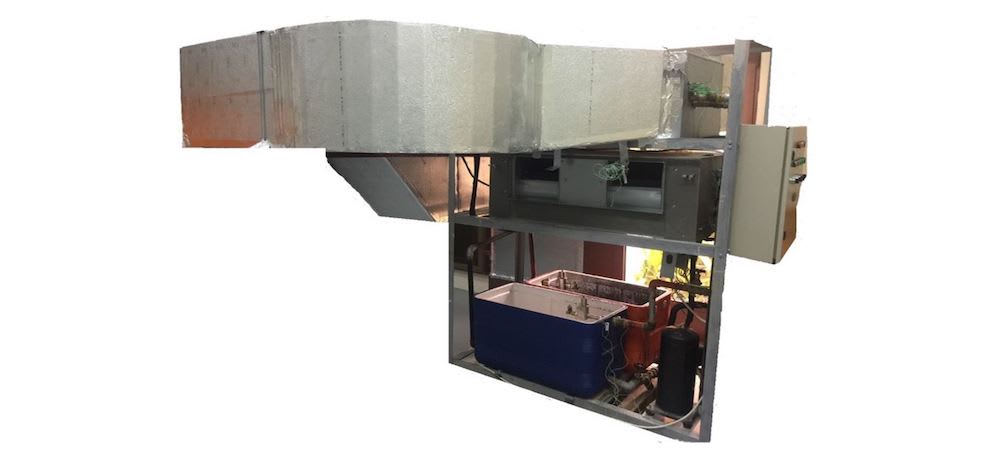
The increased demand of energy in domestic applications necessitates the development of innovative engineering solutions in building Heating Ventilating, and Air Conditioning (HVAC). As the biggest energy consuming sector in domestic buildings, more focus is currently directed to decrease air conditioning energy consumption. Double-pipe heat exchangers are considered as one of the practical solutions in today`s HVAC industry. Nevertheless, there are few studies focusing on utilizing double-pipe heat exchangers in air conditioning applications.
This product is an air conditioning unit based on double-pipe condenser and evaporator. Deionized Water (DIW) was used as the secondary heat transfer fluid for both the evaporator and the condenser units with R-22 as the AC system refrigerant. Experimental results on the air conditioning unit prototype showed a promising reduction in the compressor work and an increase in the system Coefficient of Performance (COP) when utilizing double-pipe evaporator and condenser. The collected data showed that system efficiency depends on the evaporator DIW flowrate more than condenser DIW flowrate. By increasing the DIW flowrate in the evaporator, the compressor work was shown to decrease while the COP was shown to increase. In comparison with the standard rated air conditioning unit, utilizing a double-pipe evaporator and condenser units with the maximum DIW flowrates resulted in a decrease of about 53% in the compressor work and a similar percentage of increase in the system COP.
The air conditioning system is of 17.7 kW cooling capacity was constructed with double-pipe evaporator and condenser for the present experimental study. The system runs on the standard vapor compression refrigeration cycle which consists of the four major components; an evaporator, a condenser, capillary tubes, and a compressor. The evaporator and the condenser units utilized in this system were of double-pipe heat exchanger type at which the refrigerant is allowed to exchange heat with a running DIW in addition to ambient air. In the evaporator, R-22 refrigerant runs in the inner pipe while the DIW runs in the outer pipe. On the other hand, R-22 refrigerant runs in the outer pipe while the DIW runs in the inner pipe in the condenser unit. Both the refrigerant and the DIW run in a co-current flow configuration where the two fluids flow in a parallel direction. The evaporator and the condenser pipes cross-sections in Figure 1 illustrate the flow of the DIW and the refrigerant in each heat exchanger.
This product is able to significantly cut the energy costs of conventional air conditioning units and eventually reduce the amount of Carbon dioxide in the world.
Video
-
Awards
-
 2017 Top 100 Entries
2017 Top 100 Entries
Like this entry?
-
About the Entrant
- Name:Seif Mahmoud
- Type of entry:teamTeam members:Seif Mahmoud
Saud Ghani
Mohamed Rashwan - Software used for this entry:Comsol
- Patent status:pending





